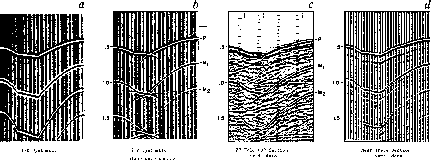 |
Figure 9 Diffracted multiple-reflection examples: (a) 1-D synthetic, (b) 2-D synthetic, vertical plane-wave source, (c) 27-fold CDP data section (GSI), (d) near-trace section. (Riley)
By 1974, wave-equation methods had established themselves as a successful way to migrate CDP-stacked sections. Bolstered by this success, Don Riley and I set out to apply the wave equation to the problem of predictive suppression of deep-water multiple reflections. Hypothesizing that diffraction effects were the reason for all the difficulty that was being experienced then with deep-water multiple reflection, we developed a method for the modeling and predictive removal of diffracted multiple reflections (see FGDP, Chapter 11-4). We didn't realize that in practice the multiple reflection problem would be so much more difficult than the primary reflection problem. For primaries, the same basic migration method works on zero-offset sections, CDP-stacked sections, or vertical-incidence plane-wave sections. Our multiple-suppression method turned out to be applicable only to vertical plane-wave stacks. Don Riley prepared Figure 9, which shows some comparisons.
 |
One thing to keep in mind while studying the comparisons in Figure 9 is that on the field data there are likely to be aspects of propagation in three dimensions that may go unrecognized. The third dimension is always a ``skeleton in the closet.'' It doesn't usually spoil two-dimensional migration, but that doesn't assure us that it won't spoil 2-D wave-equation multiple suppression.